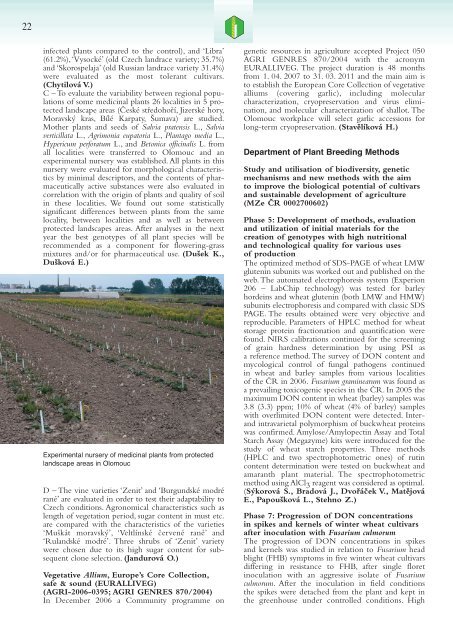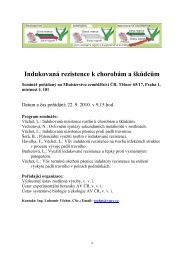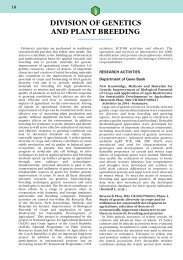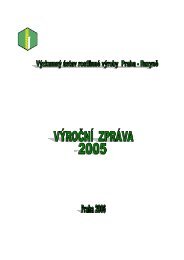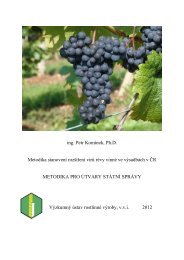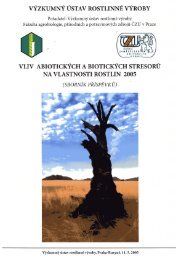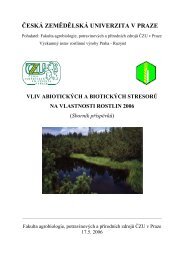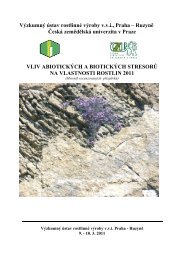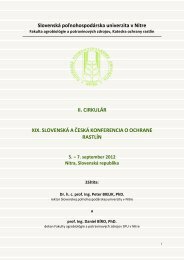00 ZLOM VURV 06 v roce 07
00 ZLOM VURV 06 v roce 07
00 ZLOM VURV 06 v roce 07
Create successful ePaper yourself
Turn your PDF publications into a flip-book with our unique Google optimized e-Paper software.
22<br />
infected plants compared to the control), and ‘Libra’<br />
(61.2%),‘Vysocké’ (old Czech landrace variety; 35.7%)<br />
and ‘Skorospelaja’ (old Russian landrace variety 31.4%)<br />
were evaluated as the most tolerant cultivars.<br />
(Chytilová V.)<br />
C – To evaluate the variability between regional populations<br />
of some medicinal plants 26 localities in 5 protected<br />
landscape areas (âeské stfiedohofií, Jizerské hory,<br />
Moravsk˘ kras, Bílé Karpaty, ·umava) are studied.<br />
Mother plants and seeds of Salvia pratensis L., Salvia<br />
verticillata L., Agrimonia eupatoria L., Plantago media L.,<br />
Hypericum perforatum L., and Betonica officinalis L. from<br />
all localities were transferred to Olomouc and an<br />
experimental nursery was established. All plants in this<br />
nursery were evaluated for morphological characteristics<br />
by minimal descriptors, and the contents of pharmaceutically<br />
active substances were also evaluated in<br />
correlation with the origin of plants and quality of soil<br />
in these localities. We found out some statistically<br />
significant differences between plants from the same<br />
locality, between localities and as well as between<br />
protected landscapes areas. After analyses in the next<br />
year the best genotypes of all plant species will be<br />
recommended as a component for flowering-grass<br />
mixtures and/or for pharmaceutical use. (Du‰ek K.,<br />
Du‰ková E.)<br />
Experimental nursery of medicinal plants from protected<br />
landscape areas in Olomouc<br />
D – The vine varieties ‘Zenit’ and ‘Burgundské modré<br />
rané’ are evaluated in order to test their adaptability to<br />
Czech conditions. Agronomical characteristics such as<br />
length of vegetation period, sugar content in must etc.<br />
are compared with the characteristics of the varieties<br />
‘Mu‰kát moravsk˘’, ‘Veltlínské ãervené rané’ and<br />
‘Rulandské modré’. Three shrubs of ‘Zenit’ variety<br />
were chosen due to its high sugar content for subsequent<br />
clone selection. (Jandurová O.)<br />
Vegetative Allium, Europe’s Core Collection,<br />
safe & sound (EURALLIVEG)<br />
(AGRI-2<strong>00</strong>6-0395; AGRI GENRES 870/2<strong>00</strong>4)<br />
In December 2<strong>00</strong>6 a Community programme on<br />
genetic resources in agriculture accepted Project 050<br />
AGRI GENRES 870/2<strong>00</strong>4 with the acronym<br />
EURALLIVEG. The project duration is 48 months<br />
from 1. 04. 2<strong>00</strong>7 to 31. 03. 2011 and the main aim is<br />
to establish the European Core Collection of vegetative<br />
alliums (covering garlic), including molecular<br />
characterization, cryopreservation and virus elimination,<br />
and molecular characterization of shallot. The<br />
Olomouc workplace will select garlic accessions for<br />
long-term cryopreservation. (Stavûlíková H.)<br />
Department of Plant Breeding Methods<br />
Study and utilisation of biodiversity, genetic<br />
mechanisms and new methods with the aim<br />
to improve the biological potential of cultivars<br />
and sustainable development of agriculture<br />
(MZe âR <strong>00</strong>027<strong>00</strong>602)<br />
Phase 5: Development of methods, evaluation<br />
and utilization of initial materials for the<br />
creation of genotypes with high nutritional<br />
and technological quality for various uses<br />
of production<br />
The optimized method of SDS-PAGE of wheat LMW<br />
glutenin subunits was worked out and published on the<br />
web. The automated electrophoresis system (Experion<br />
2<strong>06</strong> – LabChip technology) was tested for barley<br />
hordeins and wheat glutenin (both LMW and HMW)<br />
subunits electrophoresis and compared with classic SDS<br />
PAGE. The results obtained were very objective and<br />
reproducible. Parameters of HPLC method for wheat<br />
storage protein fractionation and quantification were<br />
found. NIRS calibrations continued for the screening<br />
of grain hardness determination by using PSI as<br />
a reference method.The survey of DON content and<br />
mycological control of fungal pathogens continued<br />
in wheat and barley samples from various localities<br />
of the âR in 2<strong>00</strong>6. Fusarium graminearum was found as<br />
a prevailing toxicogenic species in the âR. In 2<strong>00</strong>5 the<br />
maximum DON content in wheat (barley) samples was<br />
3.8 (3.3) ppm; 10% of wheat (4% of barley) samples<br />
with overlimited DON content were detected. Interand<br />
intravarietal polymorphism of buckwheat proteins<br />
was confirmed. Amylose/Amylopectin Assay and Total<br />
Starch Assay (Megazyme) kits were introduced for the<br />
study of wheat starch properties. Three methods<br />
(HPLC and two spectrophotometric ones) of rutin<br />
content determination were tested on buckwheat and<br />
amaranth plant material. The spectrophotometric<br />
method using AlCl 3 reagent was considered as optimal.<br />
(S˘korová S., Bradová J., Dvofiáãek V., Matûjová<br />
E., Papou‰ková L., Stehno Z.)<br />
Phase 7: Progression of DON concentrations<br />
in spikes and kernels of winter wheat cultivars<br />
after inoculation with Fusarium culmorum<br />
The progression of DON concentrations in spikes<br />
and kernels was studied in relation to Fusarium head<br />
blight (FHB) symptoms in five winter wheat cultivars<br />
differing in resistance to FHB, after single floret<br />
inoculation with an aggressive isolate of Fusarium<br />
culmorum. After the inoculation in field conditions<br />
the spikes were detached from the plant and kept in<br />
the greenhouse under controlled conditions. High


